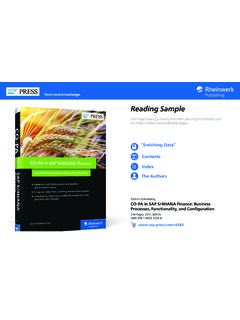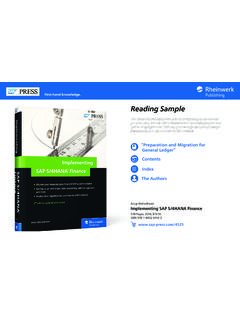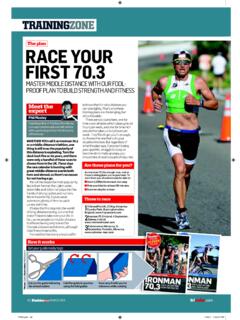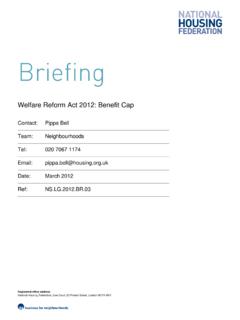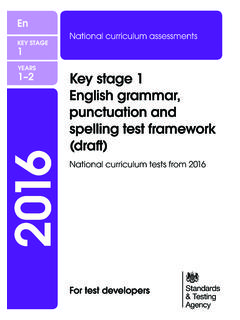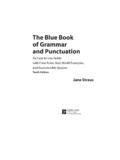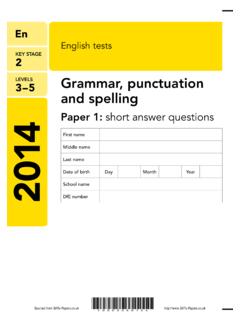Transcription of 2 English grammar, punctuation and spelling test
1 This document sets out the performance descriptors that will be used to set the standards on the English grammar , punctuation and spelling tests in 2013. In all previous National Curriculum tests, the reported outcome for each child has been a National Curriculum level as defined by the National Curriculum level descriptors for each attainment target. However, this test does not align fully with any single attainment target and therefore it is not strictly possible to determine a National Curriculum level. Therefore, outcomes will be indicative of children working at a particular performance descriptors in this document describe what is expected of a minimally competent child at the indicative level in order for participants at a standard-setting meeting to make judgements in relation to test subject specific content is identified to indicate performance at each level in the performance descriptors, there are other factors that affect a pupil s ability to answer a question.
2 Complexity of language, contextual complexity (abstraction rating), cognitive level and response strategy. As a result, pupils working at, for example, level 4 may not be able to answer questions with content identified as suitable for level 4 pupils if the question involves more than one area of content or where the context is complex. The test framework contains more information on the factors that may influence performance descriptors have been developed by STA and were validated by a group of practising teachers who represented a range of experience and backgrounds from both primary and secondary schools.
3 These teachers will also take part in the standard-setting exercise. The standard-setting exercise will take place in June following the live test administration in STAGE2 English grammar , punctuation and spelling testPerformance descriptorsJUNE2 013NC LevelDescriptionLevel 3: performance in the Short answer questions and the spelling task Children know and can identify some word classes, such as nouns, verbs and adjectives; they can identify noun phrases, substitute nouns with simple pronouns and show a general understanding of simple past and present tense. Children can identify and select simple ( temporal / causal) connectives and are able to use these when writing simple and compound sentences.
4 They can identify some straightforward subordinating connectives ( because) and sometimes use these when writing sentences. They can use imperatives to form commands. Children are beginning to be aware of Standard English usage. Children s knowledge of how to demarcate straightforward sentences is mostly secure, including the use of capital letters, full stops, question marks and exclamation marks. Commas in lists and some limited speech punctuation are usually used accurately. They can usually apply basic punctuation at word level ( capitalisation of proper nouns).
5 Children demonstrate an understanding of generally appropriate words, although the range may be limited. spelling is usually accurate, including that of common polysyllabic words. There may be errors with some inflected endings, as well as some incorrect but phonetically plausible 4: performance in the Short answer questions and the spelling task Children are familiar with a range of word classes and their use, including adverbs and prepositions. They expand noun phrases, show understanding of a variety of verb forms and make generally accurate choices of tense. Children recognise and write different types of sentences when prompted to do so.
6 They understand how to use, and can identify, imperatives in commands. They can identify and use subordinate clauses to form straightforward complex sentences, typically following the main clause in a sentence. Pronouns and a limited range of text connectives are chosen to support cohesion. Children understand some features of the grammar of Standard English . Basic sentence demarcation is secure and there is some correct use of commas to mark clauses or phrases. Use of inverted commas to denote speech, and apostrophes for omission, is generally accurate. Children s choices of vocabulary are generally accurate when selecting synonyms and antonyms.
7 spelling is generally accurate, including that of polysyllabic words that conform to regular patterns, and less common prefixes and suffixes ( ir- il- / -ible, -ify).NC LevelDescriptionLevel 5: performance in the Short answer questions and the spelling task Children have a secure understanding of most word classes listed in the programme of study. When prompted by the questions, they use complex verb forms, including modals. They understand and can demonstrate knowledge of the transitions between tenses. Children s understanding of a variety of sentence structures is mostly secure, including fronted adverbials and embedded relative clauses.
8 They know and can use appropriately a wide range of connectives, as well as pronouns associated with reference chains to support cohesion. Children are able to choose Standard English appropriate to formal situations and have a wide vocabulary from which they make relevant choices. A range of punctuation , including brackets, dashes and apostrophes, is almost always used accurately in constructed response questions. Speech is correctly punctuated and the use of commas to mark phrases or clauses within sentences is generally accurate. Children have a basic understanding of colons and ellipsis.
9 Words with complex regular patterns are usually spelt correctly. There may be occasional errors with unstressed syllables and complex silent letter patterns (chrono- / -mn).Level 6: performance in the Short answer questions and the spelling task Children have a secure understanding of a range of word classes, including different types of nouns and pronouns. They understand how to recognise and use a range of grammatical structures, including complex noun and prepositional phrases, when asked to do this in both closed and constructed response questions. They use a range of verb forms, including complex modals, impersonal constructions and passives for formality.
10 Children understand and can use embedded subordinate clauses and their control and placement of phrases and clauses within complex sentences is mostly secure. They know and use a wide range of words that would support cohesion, including the precise use of more complex connectives ( nevertheless, moreover). Children are secure in their ability to use Standard English when appropriate, including subject / verb agreement when experimenting with more sophisticated syntax in constructed response questions. Children can use a full range of punctuation , including colons and semi-colons, correctly and are able to apply these to more sophisticated grammatical structures when prompted by the questions.





